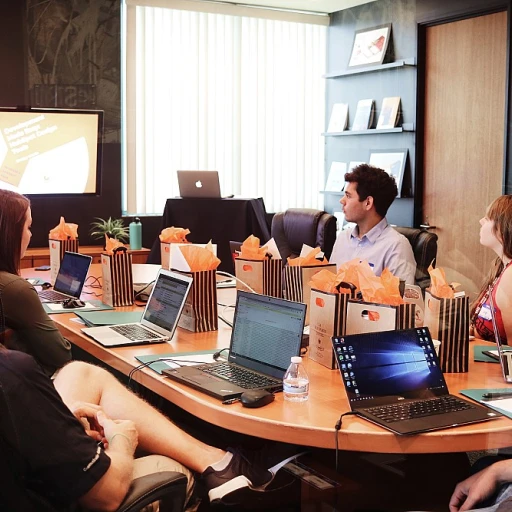
Understanding the Need for Reskilling
The Growing Importance of Skill Development
In today's fast-evolving work landscape, the need for reskilling has become more critical than ever. Traditional jobs are being transformed by technology, and new roles are emerging at a rapid pace. This dynamic environment necessitates that employees continuously update their skills to remain relevant and competitive. Companies recognize this demand and seek effective ways to implement reskilling initiatives.
Transformative Changes in Job Roles
With the integration of advanced technologies across industries, many traditional roles have undergone significant changes. As mundane tasks are increasingly automated, the demand for new skill sets is on the rise. For instance, team members are expected to adapt not only to technical expertise but also to expand their capabilities in problem-solving and critical thinking.
Leveraging a Comprehensive Onboarding Process
An effective onboarding program that incorporates structured training can expedite the reskilling journey. By employing a well-rounded onboarding experience, companies can swiftly integrate new hires and set the foundation for ongoing learning. This requires a focus on not just initial onboarding training, but a continuous development process that leverages a robust learning management system (LMS).
Investing in Continuous Learning
Organizations that prioritize employee training have found that a course library — accessible through efficient LMS software — supports lifelong learning. This learning management approach meets the need for employees to reskill in real time, allowing them to engage with new content and courses as the workplace evolves.
The Role of an Onboard Learning Management System
The Importance of Onboarding and Continuous Learning
A key component of adapting to an ever-evolving workplace is embracing the value of onboarding and continuous learning. Implementing a seamless onboarding program is critical to the success of new hires and employees transitioning into new roles. This initial phase should serve as a foundation for continual growth and development.Utilizing an Onboard LMS for Enhanced Learning
An onboarding learning management system (LMS) can significantly streamline the training process. By integrating this technology, organizations provide a structured learning path that begins with efficient employee onboarding. This approach not only equips new team members with essential skills but also offers updated content to ensure that all employees stay competent and informed.Key Features for Effective Employee Training
When selecting an onboard LMS, organizations should ensure it encompasses the following features:- A comprehensive course library to cater to diverse learning needs and preferences.
- User-friendly interface for a seamless onboarding experience.
- Real-time tracking capabilities for monitoring progress and engagement.
- Customizable online training courses tailored to specific roles or industries.
Team Collaboration in Learning and Development
An LMS facilitates collaboration among team members, promoting shared learning experiences and collective problem-solving. This collaboration is essential for fostering a culture of continuous improvement. Incorporating key questions for effective enablement and training content creation can further enhance the adaptability and effectiveness of your training programs. By thoughtfully employing an LMS, companies position themselves to address the reskilling needs of their teams, preparing them for the current challenges and future opportunities.Features of a Robust Learning Management System
Essential Capabilities of a Comprehensive System
A comprehensive Learning Management System (LMS) plays a pivotal role in the reskilling process. Its features are crucial for successful onboarding, training, and continuous learning of employees. Understanding these features can significantly enhance the management of talent development within any organization.- Course Library and Content Management: At the heart of any LMS is a robust course library, supported by efficient content management. A well-stocked library offers ample opportunities for employees to explore various topics, equipping them with a wide range of skills.
- Customizable Onboarding Programs: A top-tier LMS will provide customizable onboarding programs that cater to the diverse needs of new hires. This ensures that onboarding experiences align with company goals while accommodating individual learning paces.
- Integration and Compatibility: Success in onboarding and training often depends on how well the LMS integrates with existing company systems. Seamlessly compatible software ensures that employees and team members have a smooth onboard experience.
- Real-Time Tracking and Feedback: The ability to track employee progress in real time and provide immediate feedback enhances learning experiences. This feature allows managers to identify gaps swiftly and adjust courses or techniques as necessary.
- Interactive and Engaging Learning Experiences: An LMS that provides interactive content fosters better engagement. Features such as quizzes, discussion forums, and live sessions can make learning more dynamic and effective.
Implementing a Learning Management System for Reskilling
Strategic Planning for Effective Onboarding with an LMS
Implementing a comprehensive Learning Management System (LMS) for reskilling requires a strategic approach that aligns with an organization’s objectives and employee growth. A successful rollout can transform the employee onboarding experience, facilitating smooth transitions and optimal learning outcomes. Here’s a guideline to implementing an effective LMS.
Conducting Needs Assessment and Setting Objectives
Before selecting an LMS platform, it's vital for management to assess the current skill gaps and future needs of their team members. By setting clear objectives, businesses ensure that the courses and content provided directly support their overall strategy. This step involves gathering insights from employees across various levels to form a comprehensive understanding of the training needs.
Customization and Integration
A robust LMS should offer customizable features to tailor the onboarding program to specific organizational needs. Integration with existing systems is crucial for seamless data flow and operational coherence. Customizable options enable personalized learning experiences, enhancing employee training by addressing individual learning styles and roles within the organization.
Developing Engaging Content and Courses
The effectiveness of an LMS greatly depends on the quality of its course library. Developing engaging and relevant training materials is essential. This involves providing diverse content formats, such as videos, quizzes, and simulations, which can facilitate various learning preferences and increase engagement. Ensuring that the content remains updated and aligned with industry standards is necessary for sustained learning.
Facilitating Real-Time Feedback and Support
Real-time feedback mechanisms allow employees and managers to monitor progress and identify areas for improvement promptly. An LMS should support continuous interaction between learners and trainers, ensuring that the training management process remains dynamic and responsive to evolving needs.
Monitoring and Continuous Improvement
After launching the LMS, ongoing assessment and refinement of the onboarding programs are crucial. Analyzing data insights from the LMS enables management to understand the impact of training sessions and refine the process for better alignment with business goals. This continuous loop of feedback and enhancements ensures that the LMS remains effective and pertinent to employee development.
Overcoming Challenges in Reskilling
Navigating the Hurdles in Skills Development
Reskilling represents a pivotal shift in how organizations approach workforce development. While the need for reskilling is clear, executing it effectively involves tackling various challenges. First, resistance to change is a significant barrier. Employees may be hesitant to embrace new training methods, particularly if they are accustomed to traditional learning experiences. Addressing these concerns is crucial. Ensuring a seamless onboarding process for new hires and existing team members can help facilitate a culture of continuous learning. The integration of an onboard learning management system (LMS) is another challenge. A successful implementation goes beyond merely adopting the software; it involves aligning the system's features with organizational goals. Selecting an LMS that offers diverse options like online training, real-time updates, and an extensive course library can enhance the overall onboarding experience. Moreover, limited resources, both in terms of time and budget, often impede the reskilling process. Time constraints can affect the availability and participation of employees in training programs. Thus, developing flexible online courses that employees can engage with at their own pace can alleviate time pressures. Communication between management and employees is also critical. Keeping everyone informed about the benefits of reskilling initiatives and the importance of continuous training can boost participation and commitment. Engaging employees by highlighting the transferability of skills acquired through programs can increase buy-in. Finally, evaluating the success of onboarding training and other courses requires clear metrics. Effective learning management systems include tools for tracking progress and measuring outcomes. By tapping into these features, organizations can refine their strategies to better meet training objectives. Overcoming these challenges necessitates a thoughtful approach, with a focus on fostering an inclusive and adaptable learning culture throughout the organization.Measuring the Success of Reskilling Programs
Evaluating the Impact of Reskilling Initiatives
In ensuring the effectiveness of reskilling programs, it's crucial to employ a structured approach to measure their success. Firstly, assess the onboarding experience and the integration of a learning management system (LMS). A well-implemented onboarding program plays a pivotal role in this regard. Employees should feel supported throughout their journey, benefiting from an efficient onboarding process with an intuitive onboard LMS.- Employee Engagement and Satisfaction: Survey team members to gauge their satisfaction with the online training and overall learning experience. Positive feedback indicates that the onboarding LMS is meeting employee needs.
- Completion and Competency Rates: Track the completion rates of courses within the LMS software and evaluate whether team members have gained the necessary skills. Higher completion rates and improved competencies suggest a successful reskilling process.
- Performance Metrics: Analyze changes in employee performance before and after the training management interventions. Improvement in job performance often signifies effective training and learning experiences.
- Feedback Mechanisms: Implement feedback channels to collect real-time responses on courses and LMS employee features. Constructive feedback can guide future improvements within the platform or system.













